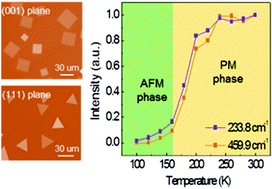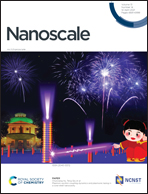Controlled synthesis and Raman study of a 2D antiferromagnetic P-type semiconductor: α-MnSe†
Abstract
Two-dimensional (2D) non-van der Waals magnetic materials have attracted considerable attention due to their high-temperature ferromagnetism, active surface/interface properties originating from dangling bonds, and good stability under ambient conditions. Here, we demonstrate the controlled synthesis and systematic Raman investigation of ultrathin non-van der Waals antiferromagnetic α-MnSe single crystals. Square and triangular nanosheets with different growth orientations can be achieved by introducing different precursors via the atmospheric chemical vapor deposition (APCVD) method. The temperature-dependent resonant enhancement in the Raman intensity of two peaks at 233.8 cm−1 and 459.9 cm−1 gives obvious evidence that the antiferromagnetic spin-ordering is below TN ∼ 160 K. Besides, a new peak located at 254.2 cm−1, gradually appearing as the temperature decreased from 180 K to 100 K, may also be a signature of phase transition from paramagnetic to antiferromagnetic. The phonon dispersion spectra of α-MnSe simulated by density functional perturbation theory (DFPT) match well with the observed Raman signals. Moreover, a fabricated α-MnSe phototransistor exhibits p-type conducting behavior and high photodetection performance. We believe that these findings will be beneficial for the applications of 2D α-MnSe in magnetic and semiconducting fields.



 Please wait while we load your content...
Please wait while we load your content...